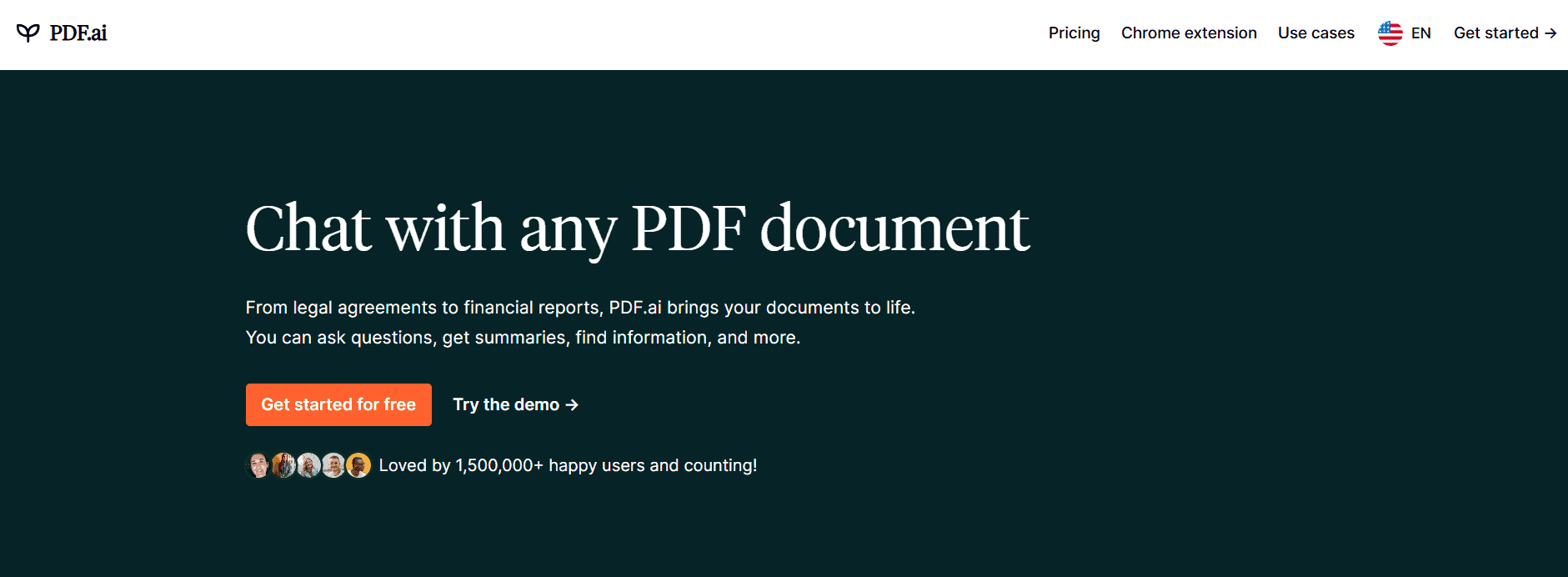1. Who is Damon Chen and what business did you start?
I’m Damon Chen, the founder of PDF.ai, a tool I created to allow people to interact with PDFs in a way that was never possible before. The idea behind PDF.ai came to me in June 2023 when I realized that people were spending so much time sifting through long PDFs manually. I wanted to build a solution that could change this experience to something that would let users simply “chat” with any PDF, and get the information they needed quickly and easily.
I started PDF.ai to make it possible for anyone, whether a student, professional, or researcher, to engage with PDFs in a more efficient and interactive way. Since launching just a few months ago, we’ve been able to grow rapidly, and it’s been exciting to see how people have adopted and benefited from the tool. Today, we’re proud to have over 350,000 users, and we’ve reached 1 million monthly website visitors.
2. How did you get the idea and what problem does it solve?
The idea for PDF.ai came when I noticed how time-consuming and frustrating it can be to extract specific information from PDFs. Whether it is research papers, legal documents, or business reports, people often spend hours scrolling, searching, and manually extracting data. I wanted to find a way to simplify that process.
I realised that with the advancements in AI, we could create a tool that allows users to “chat” with PDFs. Instead of reading through entire documents, users could ask questions and get the answers they need instantly. The problem I aimed to solve was the inefficiency and time wasted in manual document processing. PDF.ai makes it easier for users to interact with documents, extract information, and get precise answers, saving them valuable time and effort.
In essence, PDF.ai empowers anyone with a PDF to leverage AI in a way that makes work and study more productive and less tedious.
3. How did you create the first version of PDF.ai?
To create the first version of PDF.ai, I started by focusing on the core functionality, enabling users to interact with PDFs through an AI-powered chat interface. I knew that to make it scalable and reliable, the tool needed to be simple yet powerful.
The first step was assembling a talented team of developers and AI specialists who could help bring the idea to life. We used existing AI models and fine-tuned them to understand and interpret the specific context of a PDF document. This meant the AI had to process not just raw text but also understand document structure, tables, images, and other elements that often appear in PDFs.
Once the development was underway, we launched an MVP (Minimum Viable Product) to test the core functionality. Initially, we focused on a basic interface that allowed users to upload PDFs and ask simple questions. We gathered feedback from early users and refined the features, improving the accuracy of responses and expanding the range of documents the tool could handle.
Over the next few months, we iterated on the design, improved the AI’s understanding of complex documents, and added new features. The MVP was a simple but effective version of PDF.ai, and as we tested it with more users, we continued to enhance it based on their needs. This iterative process was crucial in creating a tool that users found valuable and easy to use.
4. What is the process you followed to launch your business and how did you get your initial customers?
When I launched PDF.ai, the process was all about making sure we had the right foundation in place and then getting the word out in the right way. Here’s how I went about it:
1. Building the Product
Before launching, I focused heavily on making sure the product was functional and valuable. This meant getting the MVP (Minimum Viable Product) ready first. I knew that to stand out in a competitive space like AI tools, the product had to solve a clear problem. Once the first version was ready, we tested it with a small group of users to gather feedback. Their input helped refine the user experience and ensure that the AI’s responses were accurate and useful.
2. Choosing the Right Domain
One of the major decisions I made early on was purchasing the premium domain “PDF.ai.” This domain helped position the business as an authority in the space, and more importantly, it played a massive role in SEO. A strong domain that clearly defines what your product does can make a huge difference in attracting organic traffic, which was crucial for us. The $10,000 investment in the domain quickly paid off by improving SEO and helping us gain visibility.
3. Generating Buzz Before Launch
I wanted to make sure that when we launched, there was already some excitement around PDF.ai. So, I started by creating anticipation with teaser content on social media platforms. I also began reaching out to influencers in the tech and AI spaces to get them excited about the product. This helped us build an initial following before the actual launch.
4. Leveraging Organic Traffic & SEO
As we launched, we focused heavily on search engine optimization (SEO). With our premium domain, we were able to rank well for relevant keywords like “PDF AI” and “AI PDF.” This organic traffic helped us reach a larger audience without spending much on ads. As our website traffic grew, so did our user base. By focusing on high-quality content and optimizing the site, we were able to gain traction with people searching for a solution like ours.
5. Using Viral Video Content & Social Media
One of the most effective methods we used to attract our first customers was viral content. I hired a full-time influencer to create engaging, shareable content for our Instagram. This included quick demonstrations of the tool, tutorials, and funny, relatable content about AI and PDFs. It worked really well our Instagram grew quickly, and we saw a significant increase in sign-ups.
6. Referrals and Word of Mouth
Once we had a solid user base, we focused on encouraging word-of-mouth referrals. Our tool was viral by nature, which helped spread the word. We also took advantage of platforms like TikTok and Instagram, where people would share their experiences with PDF.ai and recommend it to others.
7. Affiliate Program
A few months in, we launched an affiliate program that offered a 30% commission on all payments within 12 months. This has helped us expand our reach even further by incentivizing others to promote the tool. Early affiliates built landing pages to promote PDF.ai, driving thousands of new visitors and customers.
8. Press Coverage
Lastly, I worked hard to get media coverage. One of the biggest wins early on was when PDF.ai was mentioned by La Vanguardia, a major Spanish newspaper. This gave us exposure to an international audience and led to a surge in traffic from Spanish-speaking users. The media coverage also gave us an SEO boost thanks to the strong backlinks.
By combining all these strategies, we were able to successfully launch PDF.ai, attract our initial customers, and generate significant traffic within the first few months. The key was a combination of smart SEO, viral marketing, and leveraging organic channels.
5. What strategies have you found effective in attracting and retaining customers?
Here are the five main strategies that have been effective in attracting and retaining customers for PDF.ai:
Strong SEO and Domain Name: Choosing the premium domain “PDF.ai” helped us rank high for important keywords and boosted organic traffic, making it easier for potential customers to find us.
Viral Content on Social Media: Hiring an influencer to create daily viral content on Instagram significantly boosted engagement, growing our follower count and encouraging users to try the product.
Referral and Affiliate Programs: The 30% commission affiliate program has driven significant traffic and customer retention, with affiliates creating landing pages that attract thousands of visitors.
Press Coverage and Publicity: Media mentions, like the one in La Vanguardia, have brought us new customers and provided an SEO boost, helping us gain credibility and increase user trust.
Customer Feedback and Continuous Improvement: Actively gathering user feedback and regularly updating the product has kept customers engaged and loyal, ensuring they feel valued and that the product continues to meet their needs.
6. What business lesson you learned while building and scaling PDF.ai?
While building and scaling PDF.ai, I learned several valuable business lessons:
1. The Power of a Strong Domain: Investing in a premium domain like “PDF.ai” was one of the best decisions. It not only helped us establish credibility but also gave us an edge in SEO, driving organic traffic right from the start.
2. Virality Can Drive Growth: Creating a product with viral potential, like PDF.ai, made a huge difference. By leveraging viral content on social media and media mentions, we were able to attract a wide audience quickly.
3. Don’t Undervalue Referral Programs: Our affiliate program has been a game-changer. It has helped us scale by incentivizing others to promote PDF.ai, creating a win-win situation for both us and our affiliates.
4. Customer Engagement is Key: Listening to customer feedback and continuously improving the product helped us build a loyal user base. Satisfied customers not only stick around but also act as ambassadors for your brand.
5. Diversify Your Marketing Channels: Combining different marketing strategies SEO, influencer marketing, press coverage, and affiliate programs allowed us to reach diverse audiences and create sustained growth.
7. What platforms/tools do you use for your business?
Social Media: Instagram, TikTok, Twitter
SEO: Ahref
Email Marketing: Klaviyo
8. What advice would you give young entrepreneurs who are just starting or looking to get started?
My advice for young entrepreneurs is to start by focusing on solving a real problem that provides value to your audience. Begin with a minimum viable product and improve it based on feedback, rather than trying to perfect everything upfront. Leverage organic growth channels like SEO and social media to expand without heavy spending, and invest in a strong domain name that reflects your business. Persistence is key in building a business, so stay consistent and patient through the ups and downs. Keep learning, adapting, and moving forward, and success will follow.
Also Read stories of other Founders:
Looka earns $150K/month by making logo design easy
How this man went from drug dealer to $100 million company founder
How Jijo Sunny Built Buy Me A Coffee into a $35 Million Platform








